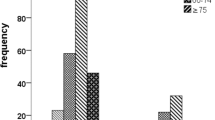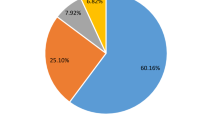Abstract
Study design:
A cross-sectional study.
Objectives:
This study was performed for epidemiological assessment of Iranian Traumatic Spinal Cord Injuries (TSCI), referred to a specialized spine center.
Setting:
Patient recruitment and evaluations were conducted at the Brain and Spinal Injury Research Center, Tehran, Iran.
Methods:
This study was performed from September 2011 to March 2015 on 1137 consecutive TSCIs. History, clinicoradiological findings as well as chronic complications and social integration were recorded. The capture–recapture method was used to calculate a rough estimation of TSCI prevalence in Tehran Province.
Results:
Our report includes 1137 cases with a mean age of 29.1 years (s.d.=11.2 year)—79.2% of them being male (M/F=3.8/1). Rough estimation of TSCI prevalence in Tehran province was 2.36 per 10 000 population. Regarding etiology, 61.8% were due to motor vehicle accident (MVA), followed by falling 24.5%, heavy drop 5.2%, violence 3.8%, sport 2.8% and others causes 1.9%. Regarding injury level, 31.5% were cervical, 57.9% thoracic and 10.6% lumbar. Complete lesions were 53.5% of patients and 46.5% were incomplete. Most common neurological type was T1-S5 (American Spinal Injury Association Impairment Scale: A, B, C, 61.7%). Most common complications included urinary tract infection followed by pressure sore (grade III and IV, 37.5%), autonomic dysreflexia (37%) and neuropathic pain (31.2%). Substance abuse was observed in 8.8% of cases. Overall, ~25% in our cases were employed after TSCI. Secondary divorce was also much more frequent than normal matched controls.
Conclusion:
MVA was the most common cause for TSCI. The elderly subjects were less frequent among our patients than more developed countries. The high rate of unemployment and divorce in our cases deserves special consideration.
Similar content being viewed by others
Log in or create a free account to read this content
Gain free access to this article, as well as selected content from this journal and more on nature.com
or
References
Pickett W, Simpson K, Walker J, Brison RJ . Traumatic spinal cord injury in Ontario, Canada. J Trauma 2003; 55: 1070–1076.
Furlan JC, Sakakibara BM, Miller WC, Krassioukov AV . Global incidence and prevalence of traumatic spinal cord injury. Can J Neurol Sci 2013; 40: 456–464.
Bakhtiyari M, Mehmandar MR, Mirbagheri B, Hariri GR, Delpisheh A, Soori H . An epidemiological survey on road traffic crashes in Iran: application of the two logistic regression models. Int J Inj Contr Saf Promot 2014; 21: 103–109.
Wyndaele M, Wyndaele JJ . Incidence, prevalence and epidemiology of spinal cord injury: what learns a worldwide literature survey? Spinal Cord 2006; 44: 523–529.
Jain NB, Ayers GD, Peterson EN, Harris MB, Morse L, O'Connor KC et al. Traumatic spinal cord injury in the United States, 1993-2012. Jama 2015; 313: 2236–2243.
Aito S, Tucci L, Zidarich V, Werhagen L . Traumatic spinal cord injuries: evidence from 30 years in a single centre. Spinal Cord 2014; 52: 268–271.
Botterell EH, Jousse AT, Kraus AS, Thompson MG, WynneJones M, Geisler WO . A model for the future care of acute spinal cord injuries. Can J Neurol Sci 1975; 2: 361–380.
Chiu WT, Lin HC, Lam C, Chu SF, Chiang YH, Tsai SH . Review paper: epidemiology of traumatic spinal cord injury: comparisons between developed and developing countries. Asia Pacific J Public Health 2010; 22: 9–18.
Noonan VK, Kwon BK, Soril L, Fehlings MG, Hurlbert RJ, Townson A et al. The Rick Hansen Spinal Cord Injury Registry (RHSCIR): a national patient-registry. Spinal Cord 2012; 50: 22–27.
Rahimi-Movaghar V, Saadat S, Rasouli MR, Ganji S, Ghahramani M, Zarei MR et al. Prevalence of spinal cord injury in Tehran, Iran. J Spinal Cord Med 2009; 32: 428–431.
DeVivo MJ . Causes and costs of spinal cord injury in the United States. Spinal Cord 1997; 35: 809–813.
Johnson RL, Brooks CA, Whiteneck GG . Cost of traumatic spinal cord injury in a population-based registry. Spinal Cord 1996; 34: 470–480.
Post MW, Adriaansen JJ, Charlifue S, Biering-Sorensen F, van Asbeck FW . Good validity of the international spinal cord injury quality of life basic data set. Spinal Cord 2015 (e-pub ahead of print 23 June 2015; doi: 10.1038/sc.2015.9).
Powell-Cope G, Moore DH, Weaver FM, Thomason S . Perceptions of practice guidelines for people with spinal cord injury. Rehabil Nurs 2015; 40: 100–110.
Kattail D, Furlan JC, Fehlings MG . Epidemiology and clinical outcomes of acute spine trauma and spinal cord injury: experience from a specialized spine trauma center in Canada in comparison with a large national registry. J Trauma 2009; 67: 936–943.
Chiu WT, Dearwater SR, McCarty DJ, Songer TJ, LaPorte RE . Establishment of accurate incidence rates for head and spinal cord injuries in developing and developed countries: a capture-recapture approach. J Trauma 1993; 35: 206–211.
Patel AA, Dailey A, Brodke DS, Daubs M, Anderson PA, Hurlbert RJ et al. Subaxial cervical spine trauma classification: the Subaxial Injury Classification system and case examples. Neurosurg Focus 2008; 25: E8.
Vaccaro AR, Zeiller SC, Hulbert RJ, Anderson PA, Harris M, Hedlund R et al. The thoracolumbar injury severity score: a proposed treatment algorithm. J Spinal Disorders Techniques 2005; 18: 209–215.
Wyndaele JJ . Standardization of reporting data in the 'Spinal cord' journal. Spinal Cord 2012; 50: 483.
Burns S, Biering-Sorensen F, Donovan W, Graves DE, Jha A, Johansen M et al. International standards for neurological classification of spinal cord injury, revised 2011. Topics Spinal Cord Inj Rehabil 2012; 18: 85–99.
McCammon JR, Ethans K . Spinal cord injury in Manitoba: a provincial epidemiological study. J Spinal Cord Med 2011; 34: 6–10.
National Spinal Cord Injury Statistical Center. Spinal Cord Injury Facts and Figures at a Glance. J Spinal Cord Med 2013; 36: 1–2.
van den Berg ME, Castellote JM, Mahillo-Fernandez I, de Pedro-Cuesta J . Incidence of spinal cord injury worldwide: a systematic review. Neuroepidemiology 2010; 34: 184–192.
Pickett GE, Campos-Benitez M, Keller JL, Duggal N . Epidemiology of traumatic spinal cord injury in Canada. Spine (Phila Pa 1976) 2006; 31: 799–805.
Chen Y, Tang Y, Allen V, DeVivo MJ . Fall-induced spinal cord injury: External causes and implications for prevention. J Spinal Cord Med 2015.
Alshahri SS, Cripps RA, Lee BB, Al-Jadid MS . Traumatic spinal cord injury in Saudi Arabia: an epidemiological estimate from Riyadh. Spinal Cord 2012; 50: 882–884.
Mena Quinones PO NM, Al Bader Kl, Al Muraikhi AE, Al Kahlout SR . Traumatic spinal cord injury in Qatar: an epidemiological study. Middle East J Emerg Med 2002; 2: 1–4.
Raibulet TFS, Khamees MF, Eyadeh AA . Spinal Cord Injury Patients in the Physical Medicine and Rehbilitation Hospital, Kuwait - A nine-year retrospective study. Kuwait Med J 2001; 33: 211–215.
Lofvenmark I, Norrbrink C, Nilsson-Wikmar L, Hultling C, Chakandinakira S, Hasselberg M . Traumatic spinal cord injury in Botswana: characteristics, aetiology and mortality. Spinal Cord 2015; 53: 150–154.
Obalum DC, Giwa SO, Adekoya-Cole TO, Enweluzo GO . Profile of spinal injuries in Lagos, Nigeria. Spinal Cord 2009; 47: 134–137.
Knutsdottir S, Thorisdottir H, Sigvaldason K, Jonsson H Jr., Bjornsson A, Ingvarsson P . Epidemiology of traumatic spinal cord injuries in Iceland from 1975 to 2009. Spinal Cord 2012; 50: 123–126.
Hagen EM, Eide GE, Rekand T, Gilhus NE, Gronning M . A 50-year follow-up of the incidence of traumatic spinal cord injuries in Western Norway. Spinal Cord 2010; 48: 313–318.
Perez K, Novoa AM, Santamarina-Rubio E, Narvaez Y, Arrufat V, Borrell C et al. Incidence trends of traumatic spinal cord injury and traumatic brain injury in Spain, 2000-2009. Accid Analy Prev 2012; 46: 37–44.
Mathur N, Jain S, Kumar N, Srivastava A, Purohit N, Patni A . Spinal cord injury: scenario in an Indian state. Spinal Cord 2015; 53: 349–352.
Hoque MF, Grangeon C, Reed K . Spinal cord lesions in Bangladesh: an epidemiological study 1994 - 1995. Spinal Cord 1999; 37: 858–861.
Yousefzadeh Chabok S, Safaee M, Alizadeh A, Ahmadi Dafchahi M, Taghinnejadi O, Koochakinejad L . Epidemiology of traumatic spinal injury: a descriptive study. Acta Med Iran 2010; 48: 308–311.
Feng HY, Ning GZ, Feng SQ, Yu TQ, Zhou HX . Epidemiological profile of 239 traumatic spinal cord injury cases over a period of 12 years in Tianjin, China. J Spinal Cord Med 2011; 34: 388–394.
Nijendijk JH, Post MW, van Asbeck FW . Epidemiology of traumatic spinal cord injuries in The Netherlands in 2010. Spinal Cord 2014; 52: 258–263.
Bellucci CH, de Castro Filho JE, Gomes CM, de Bessa J Jr., Battistella LR, Rubio de Souza D et al. Contemporary trends in the epidemiology of traumatic spinal cord injury: changes in age and etiology. Neuroepidemiology 2015; 44: 85–90.
Krause JS, Zhai Y, Saunders LL, Carter RE . Risk of mortality after spinal cord injury: an 8-year prospective study. Arch Phys Med Rehabil 2009; 90: 1708–1715.
Wilson JR, Vaccaro A, Harrop JS, Aarabi B, Shaffrey C, Dvorak M et al. The impact of facet dislocation on clinical outcomes after cervical spinal cord injury: results of a multicenter North American prospective cohort study. Spine (Phila Pa 1976) 2013; 38: 97–103.
Cardenas DD, Hoffman JM, Kirshblum S, McKinley W . Etiology and incidence of rehospitalization after traumatic spinal cord injury: a multicenter analysis. Arch Phys Med Rehabil 2004; 85: 1757–1763.
Mann R, Schaefer C, Sadosky A, Bergstrom F, Baik R, Parsons B et al. Burden of spinal cord injury-related neuropathic pain in the United States: retrospective chart review and cross-sectional survey. Spinal Cord 2013; 51: 564–570.
Rekand T, Hagen EM, Gronning M . Spasticity following spinal cord injury. Tidsskr Nor Laegeforen 2012; 132: 970–973.
Jetha A, Dumont FS, Noreau L, Leblond J . A life course perspective to spinal cord injury and employment participation in Canada. Top Spinal Cord Inj Rehabil 2014; 20: 310–320.
Murphy G, Middleton J, Quirk R, De Wolf A, Cameron ID . Prediction of employment status one year post-discharge from rehabilitation following traumatic spinal cord injury: an exploratory analysis of participation and environmental variables. J Rehabil Med 2009; 41: 1074–1079.
Acknowledgements
We thank ‘Protection Center of Spinal Cord Disabled of Iran’ for their kind support of the study. Also, we thank Dr Ahmad Audeh, Asal Derakhshanrad, MSc, and Dr Shadi Derakhshanrad for their kind contribution to the program. Also, our thanks go to Dr Abolghassem Nikfallah, Dr Mohsen Maghari, Dr Amirhossein Tavakkoli, Dr Seyed Hassan Emami Razavi and Dr Abbas Norouzi Javdan for their participation in the multidisciplinary team and their contributions to the study.
Author information
Authors and Affiliations
Corresponding author
Ethics declarations
Competing interests
The authors declare no conflict of interest.
Rights and permissions
About this article
Cite this article
Derakhshanrad, N., Yekaninejad, M., Vosoughi, F. et al. Epidemiological study of traumatic spinal cord injuries: experience from a specialized spine center in Iran. Spinal Cord 54, 901–907 (2016). https://doi.org/10.1038/sc.2016.10
Received:
Revised:
Accepted:
Published:
Issue date:
DOI: https://doi.org/10.1038/sc.2016.10
This article is cited by
-
Adopting and adapting clinical practice guidelines for timing of decompressive surgery in acute spinal cord injury from a developed world context to a developing region
Acta Neurochirurgica (2023)
-
A systematic review and meta-analysis of the global epidemiology of pediatric traumatic spinal cord injuries
European Journal of Pediatrics (2023)
-
Development of Persian version of the Spinal Cord Independence Measure III assessed by interview: a psychometric study
Spinal Cord (2018)
-
Incidence of acute spinal cord injury in the Czech Republic: a prospective epidemiological study 2006–2015
Spinal Cord (2017)



